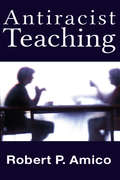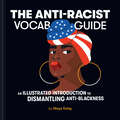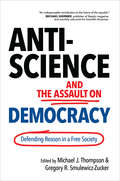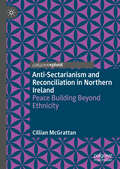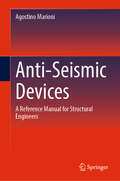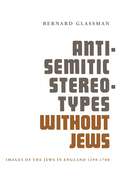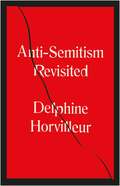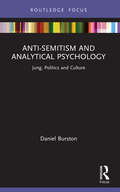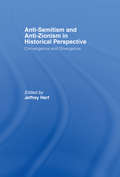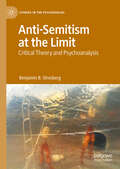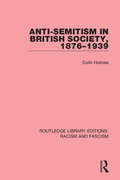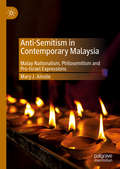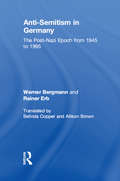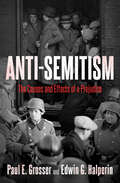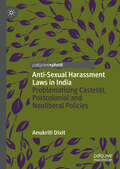- Table View
- List View
Anti-Racist Shakespeare (Elements in Shakespeare and Pedagogy)
by Nedda Mehdizadeh Ambereen DadabhoyAnti-Racist Shakespeare argues that Shakespeare is a productive site to cultivate an anti-racist pedagogy. Our study outlines the necessary theoretical foundations for educators to develop a critical understanding of the longue durée of racial formation so that they can implement anti-racist pedagogical strategies and interventions in their classrooms. This Element advances teaching Shakespeare through race and anti-racism in order to expose students to the unequal structures of power and domination that are systemically reproduced within society, culture, academic disciplines, and classrooms. We contend that this approach to teaching Shakespeare and race empowers students not only to see these paradigms but also to take action by challenging and overturning them. This title is also available as Open Access on Cambridge Core.
Anti-Racist Teaching
by Robert P. Amico<P>"Antiracist Teaching" is about awakening students to their own humanity. In order to teach about this awakening one must be in the process of awakening oneself. The author shares personal anecdotes to illustrate the kinds of changes he experienced as a result of his antiracist teaching. His book explores the questions, <br>Why is teaching about racism and white privilege to white students so difficult? <br>and What can educators do to become more effective antiracist teachers for all of their students? <P>Amico examines the cognitive and emotive obstacles that students experience in the classroom and argues that understanding these difficulties can lead to their resolution. He considers a variety of different approaches to antiracist teaching and endorses a dialogic approach. <P>Dialogue is the centerpiece of students classroom experiences; students engage in dialogue at nearly every class meeting. The dialogic approach is effective in a variety of different learning settings from K 12 classrooms, trainings, retreats, workshops, and community organizations to the college classroom. Further, the book discusses how to bring antiracist teaching into the core of university curricula.
Anti-Racist Vocab Guide: An Illustrated Introduction to Dismantling Anti-Blackness
by Maya EaleyFrom "Assimilation" to "Decolonization," "Black Wall Street" to "Police Brutality," and "Colorism" to "White Supremacy," this book equips you with the language to engage in crucial conversations around anti-Black racism.The Anti-Racist Vocab Guide is a boldly illustrated visual glossary that distills complex subjects into comprehensive yet accessible definitions of terms and provides concise and insightful explanations of historical moments. With reflection questions to use for introspection or as a starting point for hard conversations with those close to you, this book will encourage both your learning and unlearning—no matter where you are in your journey to understanding race in America.THOROUGH AND APPROACHABLE: This book presents huge topics in easy-to-understand language that welcomes readers of every experience.REFLECTION QUESTIONS: Each entry is followed by questions to encourage readers to continue their education and translate their new understanding into positive action in their daily lives.BEYOND THE BUZZWORDS: This is an invaluable resource guide that breaks down and goes beyond common phrases to provide actionable awareness.EVOCATIVE ART: Author Maya Ealey's striking art provides conceptual illustrations of each term explained in the book in her bold, passionate style.Perfect for:Anyone interested in learning more about race in AmericaPeople who want help understanding the complicated subject of racismParents, teachers, and studentsReaders of instructive and informative best sellers such as How to Be an Antiracist, White Fragility, The 1619 Project, and Do the Work!: An Antiracist Activity Book
Anti-Refugee Violence and African Politics
by Ato Kwamena OnomaUsing comparative cases from Guinea, Uganda, and the Democratic Republic of Congo, this study explains why some refugee-hosting communities launch large-scale attacks on civilian refugees whereas others refrain from such attacks even when encouraged to do so by state officials. Ato Kwamena Onoma argues that such outbreaks only happen when states instigate them because of links between a few refugees and opposition groups. Locals embrace these attacks when refugees are settled in areas that privilege residence over indigeneity in the distribution of rights, ensuring that they live autonomously of local elites. The resulting opacity of their lives leads locals to buy into their demonization by the state. Locals do not buy into state denunciation of refugees in areas that privilege indigeneity over residence in the distribution of rights because refugees in such areas are subjugated to locals who come to know them very well. Onoma reorients the study of refugees back to a focus on the disempowered civilian refugees that constitute the majority of refugees even in cases of severe refugee militarization.
Anti-SARS-CoV-2 Activity of Flavonoids
by Jen-Tsung ChenIn the past years, COVID-19 caused millions of deaths and severely damaged not only public health, but also the global economy. New variants continue to threaten human health. Thus, natural compounds for retarding infection are in high demand. This book summarizes the emerging research with flavonoids, whose application holds great promise of antivirus, anti-inflammation, antioxidative stress, and immunomodulatory. Topics include the role of flavonoids in preventing an inflammatory storm and how flavonoids interact with critical protein targets that are involved in the infection stages of COVID-19.Key Features• Highlights anti-SARS-CoV-2 drug discovery on natural products and medicinal plants• Includes all major subclasses of flavonoids that promisingly combat COVID-19 • Proposes molecular mechanisms of flavonoids against protein targets of SARS-CoV-2• Contributions from an international team of leading researchers• Provides recommendations with respect to the future research
Anti-Science and the Assault on Democracy: Defending Reason in a Free Society
by Michael J. Thompson Gregory R. Smulewicz-ZuckerDefending the role that science must play in democratic society--science defined not just in terms of technology but as a way of approaching problems and viewing the world.In this collection of original essays, experts in political science, the hard sciences, philosophy, history, and other disciplines examine contemporary anti-science trends, and make a strong case that respect for science is essential for a healthy democracy. The editors note that a contradiction lies at the heart of modern society. On the one hand, we inhabit a world increasingly dominated by science and technology. On the other, opposition to science is prevalent in many forms--from arguments against the teaching of evolution and the denial of climate change to the promotion of alternative medicine and outlandish claims about the effects of vaccinations. Adding to this grass-roots hostility toward science are academics espousing postmodern relativism, which equates the methods of science with regimes of "power-knowledge." While these cultural trends are sometimes marketed in the name of "democratic pluralism," the contributors contend that such views are actually destructive of a broader culture appropriate for a democratic society. This is especially true when facts are degraded as "fake news" and scientists are dismissed as elitists. Rather than enhancing the capacity for rational debate and critical discourse, the authors view such anti-science stances on either the right or the left as a return to premodern forms of subservience to authority and an unwillingness to submit beliefs to rational scrutiny. Beyond critiquing attitudes hostile to science, the essays in this collection put forward a positive vision for how we might better articulate the relation between science and democracy and the benefits that accrue from cultivating this relationship.
Anti-Sectarianism and Reconciliation in Northern Ireland: Peace Building Beyond Ethnicity
by Cillian McGrattanThis book addresses the limitations of dominant ways of thinking about and doing politics in Northern Ireland. Arguing for the foregrounding of anti-sectarianism as a way of displacing the divisive dynamics of religion and nationalism, it provides a new lens for studying Northern Ireland. Drawing upon a close reading of the political philosophy of Jacques Rancière, the book aligns anti-sectarianism to the ways that people refuse affiliation with the traditional ethnic values and practices. It describes this refusal as dis-identification, and reveals how dissensus acts as an alternative to the displacing of equality. Returning equality and equality claims-making to a clear position of visibility, the book provides a radical rethinking of Northern Ireland a quarter century beyond the 1998 peace accord. It will appeal to all those interested in politics and peacebuilding studies.
Anti-Seismic Devices: A Reference Manual for Structural Engineers
by Agostino MarioniThis book stands as a manual and ready reference for structural engineers on the seismic protection of civil engineering structures. Beginning with a short historical overview, the book explains the concepts of seismic protection, describes the most common types of anti-seismic devices, and summarizes the main existing standards for anti-seismic devices, with particular reference to the European Standard. It imparts expertise on the devices that is normally restricted by proprietary interests of a few specialists. Then it goes on to illustrate the main differences between European and American Standards, examine the output of the principle laboratories globally engaged in testing anti-seismic devices, and to describe state-of-art technologies to retrofit seismically existing buildings. The volume concludes with a number of accounts of projects involving the author where structures were equipped with anti-seismic devices and provides some insight on the future development of relevant technologies.
Anti-Semite and Jew: An Exploration of the Etiology of Hate
by Jean-Paul Sartre George BeckerA classic study from the author of philosophy which is a must-read for any serious student of the aetiology of hatred.
Anti-Semitic Stereotypes without Jews: Images of the Jews in England 1290-1700
by Bernard GlassmanAnti-Semitic Stereotypes Without Jews offers an exploration of English history, 1290- 1700, tracing the growth and development of these attitudes. It demonstrates that it is possible for prejudice to thrive even in the absence of a scapegoat group. Following the expulsion in the year 1290 until 1656, although there was no real Jewish community in England, the molders of public opinion kept a shadowy image of the Jew alive through sermons and religious tracts, travelogues, folklore, religious and secular drama. In his analysis, Dr. Glassman shows that despite their theological differences, Anglican, Puritan, and Catholic clergymen concurred in the negative images of Jews presented to their congregations. They pictured the Jews as Christ-killers, and related myths of how Jews performed barbaric and sacrilegious rituals. The image was to plague Anglo-Jewry after a small community was reestablished in the second half of the 17th century. The author's belief that anti-Semitism is primarily a Christian problem transcends both time and place is covered by this volume. Anti-Semitic sentiments are seen here as reflecting deep-seated, irrational responses to the Jewish people, rooted in the teachings of the church and exploited by men who needed an outlet for religious, social, and economic frustrations.
Anti-Semitism Revisited: How the Rabbis Made Sense of Hatred
by Delphine HorvilleurRabbi Delphine Horvilleur analyses the phenomenon of anti-semitism as it is viewed by those who endure it and who, through narration and literature, succeed in overcoming it. Jewish texts are replete with treatments of anti-semitism, of this endlessly paradoxical hatred, and of the ways in which Jews are perceived by others. But here, the focus is inverted: Anti-Semitism Revisited explores the hatred of Jews as seen through the lens of the sacred texts, rabbinical tradition and Jewish lore. Delphine Horvilleur gives a voice to those who are too often deprived of one, examining resilience in the face of adversity and the legacy of an ancient hatred that is often misunderstood. An engaging, hopeful and very original examination of anti-semitism: what it means, where it comes from, what are the ancient myths and tropes that are weaponised against Jewish people, and how do we take them apart.
Anti-Semitism Revisited: How the Rabbis Made Sense of Hatred
by Delphine Horvilleur"Anti-Semitism revisited in a wholly original way" Philippe Sands"Rippling with ideas on every page" Jewish Chronicle"Tackles the issue [of anti-semitism] from the perspective of a country where its manifestations have been more vicious and deadly" Financial TimesRabbi Delphine Horvilleur analyses the phenomenon of anti-semitism as it is viewed by those who endure it and who, through narration and literature, succeed in overcoming it. Jewish texts are replete with treatments of anti-semitism, of this endlessly paradoxical hatred, and of the ways in which Jews are perceived by others. But here, the focus is inverted: Anti-Semitism Revisited explores the hatred of Jews as seen through the lens of the sacred texts, rabbinical tradition and Jewish lore. Delphine Horvilleur gives a voice to those who are too often deprived of one, examining resilience in the face of adversity and the legacy of an ancient hatred that is often misunderstood. An engaging, hopeful and very original examination of anti-semitism: what it means, where it comes from, what are the ancient myths and tropes that are weaponised against Jewish people, and how do we take them apart.Translated from the French by Ruth Diver
Anti-Semitism and Analytical Psychology: Jung, Politics and Culture (Focus on Jung, Politics and Culture)
by Daniel BurstonCarl Jung angrily rejected the charge that he was an anti-Semite, yet controversies concerning his attitudes towards Jews, Zionism and the Nazi movement continue to this day. This book explores Jung’s ambivalent relationship to Judaism in light of his career-changing relationship and rupture with Sigmund Freud and takes an unflinching look at Jung’s publications, public pronouncements and private correspondence with Freud, James Kirsch and Erich Neumann from 1908 to 1960. Analyzing the religious and racial, Christian and Muslim, high-brow and low-brow varieties of anti-Semitism that were characteristic of Jung’s time and place, this book examines how Muslim anti-Semitism and anti-Zionism intensified following the Balfour Declaration (1917), fostering the resurgence of anti-Semitism on the Left since the fall of the Soviet Empire. It urges readers to be mindful of the new and growing threats to the safety and security of Jewish people posed by the resurgence of anti-Semitism around the world today. This book explores the history of the controversy concerning Jung’s anti-Semitism both before and after the publication of Lingering Shadows: Jungians, Freudians and Anti-Semitism (1991), and invites readers to reflect on the relationships between Judaism, Christianity and Zionism, and between psychoanalysis and analytical psychology, in new and challenging ways. It will be of considerable interest to psychoanalysts, historians and all those interested in the history of analytical psychology, anti-Semitism and interfaith dialogue.
Anti-Semitism and Anti-Zionism in Historical Perspective: Convergence and Divergence
by Jeffrey HerfPreviously published as a special issue of The Journal of Israeli History, this book presents the reflections of historians from Israel, Europe, Canada and the United States concerning the similarities and differences between anti-Zionism and anti-Semitism primarily in Europe and the Middle East. Spanning the past century, the essays explore the continuum of critique from early challenges to Zionism and they offer criteria to ascertain when criticism with particular policies has and has not coalesced into an "ism" of anti-Zionism and anti-Semitism. Including studies of England, France, Germany, Poland, the United States, Iran and Israel, the volume also examines the elements of continuity and break in European traditions of anti-Semitism and anti-Zionism when they diffused to the Arab and Islamic. Essential course reading for students of religious history.
Anti-Semitism and Its Metaphysical Origins
by David PattersonThis book articulates a deeper understanding of the phenomenon of Jew hatred as a metaphysical aspect of the human soul. Proceeding from the Jewish thinking that the anti-Semites oppose, David Patterson argues that anti-Semitism arises from the most ancient of temptations, the temptation to be as God, and thus to flee from an absolute accountability to and for the other human being.
Anti-Semitism and Psychiatry: Recognition, Prevention, and Interventions
by Mary V. Seeman H. Steven Moffic John R. Peteet Ahmed HankirFollowing World War II and the exposure of the concentration camps, psychiatry turned its attention to a vast range of cultural concerns with results that seemed to indicate a decline of stigma over time. However, it is now clear that whatever drives prejudices, especially in the case of anti-Semitism, was just dormant and perhaps not fully understood. Hate crimes and anti-Semitism broad recently re-emerged in Europe, and the United States followed shortly thereafter. The US Federal Bureau of investigation reports that New York City, which is still considered the most Jewish-friendly region in the US, experienced a 22% spike in anti-Semitic hate crimes in 2018 alone, with more extremes in other regions of the country. Neo-Nazi groups have grown stronger in the United States and abroad, often resulting in organized acts of violence. The recent Tree of Life synagogue shooting in Pittsburgh, PA demonstrated that these acts are not limited to one-on-one interactions, but sometimes as prolific, large-scale act. The medical community is not immune from biases either. The Cleveland Clinic recently fired a young doctor after she publicly declared her wishes to inject Jewish patients with lethal substances, which is only one of many hateful comments she made on social media over the course of several years. Psychiatrists in particular grapple with this as they try to serve patients of both Jewish and non-Jewish descent who struggle to process these acts of hate. Despite all of this, there is no training and no resource to guide medical professionals through these challenges. The editors of the recent Springer book, Islamophobia and Psychiatry, recognize this gap in the literature and seek to develop another high-quality text to meet this need. Written by expert clinicians in global regions where these incidents are most prevalent, the book seeks to be neither political nor opinion-based; instead, the text takes an innovative cross-cultural psychiatric interaction, similar to what was done with Springer’s new Islamophobia book. Coverage will range from foci on the social psychiatric aspects of anti-Semitism to how it may in turn infuse clinical encounters between patients and clinicians. Written by experts in this area, the insight and expertise of psychiatrists from a variety of cultural and religious backgrounds will focus on what psychiatrists need to know to combat the negative mental health impact that increasingly rise out of this particular phenomenon. Such a multi-cultural psychiatric approach has never been taken before for this topic. This discourse is the foundation for the primary goal of this book: to develop the tools needed to improve clinical outcomes for patients. Hence, this book aims to present an updated, comprehensive bio-psychosocial perspective on anti-Semitism at the interface of clinical psychiatry.
Anti-Semitism and Schooling Under the Third Reich (Studies in the History of Education)
by Gregory WegnerThis book investigates the anti-Semitic foundations of Nazi curricula for elementary schools, with a focus on the subjects of biology, history, and literature. Gregory Paul Wegner argues that any study of Nazi society and its values must probe the education provided by the regime. Schools, according to Wegner, play a major role in advancing ideological justifications for mass murder, and in legitimizing a culture of ethnic and racial hatred. Using a variety of primary sources, Wegner provides a vivid account of the development of Nazi education.
Anti-Semitism at the Limit: Critical Theory and Psychoanalysis (Studies in the Psychosocial)
by Benjamin B. StrosbergIn this book, Benjamin Strosberg explores difficulties and anxieties inherent in studying, defining, and defending against anti-Semitism by tracing a concurrent difficulty in thinking about Jewishness, which has historically served as a limit case for central social categories such as outsider, religion, race, gender, and nation. Dr. Strosberg draws on Zygmunt Bauman’s concept of proteophobia—the anxious fear of what doesn’t fit into clear-cut categories—to think more carefully about anti-Semitism as response to the complex-realities of ambivalence and otherness. The book proposes ‘negative psychology’ as a methodology for studying anti-Semitism and proteophobia rooted in psychoanalysis and Theodor Adorno’s Critical Theory. Drawing from lived experiences, contemporary events, and debates in the field, this compelling work explores the broad implications of the investigation of anti-Semitism for politics, education, and psychoanalysis, as well as the specific implications for Jewish identity and resistance.
Anti-Semitism before the Holocaust (Seminar Studies)
by Albert S. LindemannAn important new study on a complex and highly controversial topic. Albert Lindemann provides a clear and balanced guide to anti-Semitism from ancient times right through to the twentieth-century inter-war period and the Nazi Holocaust. He looks at all countries where anti-Semitism manifested itself at different times and in different ways xxx; in Russia, the US, Poland, England, Germany, South Africa, and Holland. Throughout he asks difficult and unfamiliar questions to challenge long held and misguided beliefs. An important new study which fills a gap in current literature.
Anti-Semitism in British Society, 1876-1939 (Routledge Library Editions: Racism and Fascism #2)
by Colin HolmesThis is the first detailed study of anti-semitism, as an ideology, among the British. First published in 1979, it concentrates on the crucial period between 1876 and 1939 when, against a background of Jewish immigration, war or the threat of war, and social and economic unrest, hostility towards the Jewish community reached its peak. Colin Holmes identifies the main strands of anti-semitic thought and their expression, starting with the Eastern Crisis of 1876 which sparked off the first serious manifestation of anti-semitism. He shows how, before 1914, opposition towards Jews rested on religious and other perceived cultural distinctions. It was only after the First World War that a sinister and significant change of emphasis occurred: racism now became the dominant feature of anti-semitism and was reinforced by theories of conspiracy, the most notorious being The Protocols of the Elders of Zion. Anti-semitism has no uniform cause or characteristic and a single explanation cannot suffice. This book elucidates the complex range of factors involved, using both historical and sociological methods and drawing on extensive (and sometimes controversial) research.
Anti-Semitism in Contemporary Malaysia: Malay Nationalism, Philosemitism and Pro-Israel Expressions (Palgrave Series In Asia And Pacific Studies)
by Mary J. AinslieOffering an empirical study into anti-Semitism and anti-Israel attitudes in Malaysia, this book examines the complicated nature and function of such beliefs within the contemporary context, mapping these discourses onto different ethnic and economic divisions. Based largely upon qualitative interviews with thirty Malaysian participants who detail their own experiences with and perceptions of this phenomenon, the project reveals how political actors and organizations in Malaysia achieve political success and maintain political power through investing in the Palestinian cause, simultaneously demonizing Israel and Jews to an astounding degree. However, the book also reveals how, in contrast to this state-led agenda, challenging anti-Semitism and pushing for dialogue with Israel has become a means by which progressive citizens can critique authorities and reassert their desire for a liberal and heterogenic Malaysia. The book therefore argues that both interest in and even support for Judaism and Israel may be more prominent than the official Malaysian position may suggest, with citizens holding far more complex opinions and views upon this subject matter.
Anti-Semitism in Germany: The Post-Nazi Epoch from 1945-95
by Werner Bergmann Rainer ErbThe surrender of Nazi Germany in 1945 marked the end of an epoch during which anti-Semitism escalated into genocide. In the immediate aftermath of World War II, Nazi racist ideology was discredited morally and politically, and the Allied occupation forces prohibited its dissemination in public. However, there was no overnight transformation of individual anti-Semitic attitudes among the public at large. Most surveys conducted since 1946 have confirmed the persistence of massive anti-Semitism in Germany both in the democratic West and the communist East. Based on all empirical survey data available up to now, this volume offers a thorough comparative analysis of anti-Semitism in Germany, and in particular its resurgence with the rise of right-wing extremism since unification.Anti-Semitism in Germany reflects a historically unique opportunity to compare the attitudes of two population groups that shared a common history up to 1945 and then lived under differing political conditions until 1989. The authors find distinct generational patterns in the survival and development of anti-Semitic attitudes. In the Federal Republic hostility towards Jews was more manifest among those who had been socialized to it under the Weimar Republic and Third Reich but less prevalent in subsequent generations. In contrast the authors show younger East Germans as more susceptible to anti-Semitism. The economic and cultural crises of reunification underwrote the strident anti-Zionism of the former communist regime. The authors also explore the anti-Semitic component of the recent wave of xenophobic violence and the disturbing rise of neo-Nazi political activity.This volume is especially noteworthy in its examination of a "secondary" anti-Semitism closely tied to the issue of coming to terms with the Nazi past. The motives behind persisting anti-Semitism can no longer be attributed to ethnic conflict, but go to the core discrepancy between wanting to forget and being reminded. The authors consider this phenomenon within the framework of current German political culture. In its comprehensiveness and methodological sophistication, Anti-Semitism in Germany is a major contribution to the literature on modern anti-Semitism and ethnic prejudice. It will be read by historians, political scientists, sociologists, and Jewish studies specialists.
Anti-Semitism: A Disease of the Mind
by Theodore Isaac RubinA groundbreaking work on the psychodynamics of bigotry and anti-Semitism.As a child, Ted Rubin could not understand why some people hated him and his family only because they were Jews. He soon discovered that other groups were hated and that bigotry was a dangerous disease that destroys its hosts as well as its victims.As a psychiatrist, Dr. Rubin learned that anti-Semitism and other deep-seated prejudices are non-organic diseases of the mind: malignant emotional illnesses that can be treated only by first understanding the unique psychodynamics involved. Little has been written about this aspect of bigotry. Anti-Semitism is a bold endeavor to shed light on one of humankind's most destructive and contagious illnesses, and offers hope and healing for the future.In Anti-Semitism, Rubin lays the groundwork for a person to successfully overcome hatred, to understand where it comes from and why, and to recognize that anti-Semitism devastates people, cripples self-esteem, and is capable of "engendering great suffering, horror and murder." Anyone who has wrestled with hatred or bigotry, either as the victim or the host, will find clarity and direction in Dr. Rubin's eloquent analysis.
Anti-Semitism: The Causes and Effects of a Prejudice
by Paul E Grosser Edwin G. HalperinThis study examines the long history of hatred Jews have endured at the hands of the Catholic Church from ancient Rome to the twentieth century. Anti-Semitism is one of the oldest, most persistent, and most virulent forms of hatred to plague the world. The Holocaust of World War II was the bitter fruit of centuries of prejudice passed down in Christian teachings and perceptions about the Jewish people. In this book, Paul E. Grosser and Edwin G. Haplerin present a historical analysis of anti-Semitism from the Roman Empire, through the Crusades, the Inquisition, the Reformation, and the twentieth century. Through their analysis, Grosser and Halperin reveal a pattern. They shed light on how, where, and when anti-Semitism has spread; how it is temporarily brought under control; and how it suddenly, in some far part of the world, becomes endemic again. The authors provide an illuminating survey of the causes of anti-Semitism and share theories of how the Jews have been able to survive. In conclusion, they offer some hope for the future.
Anti-Sexual Harassment Laws in India: Problematising Caste(d), Postcolonial and Neoliberal Policies
by Anukriti DixitThrough a deep dive into specific ‘problem’ representations in the policymaking on anti- sexual harassment at workplaces (SHW) in India, this book makes broader sense of gendered, caste-based and colonial regimes of power. The author takes a poststructuralist feminist approach to illustrate how these policies disregard collective action and function as gendering and caste-ing practices. The book posits that India’s anti-SHW policies produce specific ‘problems’ and subjects while neglecting certain other ‘problem’ and subject formulations. The author offers guidelines for how diverse subjects must be given equal epistemic credibility to make the policy milieu intersectionally equitable. This book will be of interest to scholars and policymakers in the fields of Gender Studies, Law, Sociology, and Organizational Studies.

